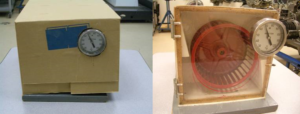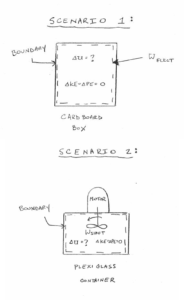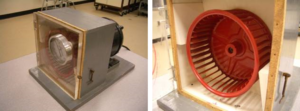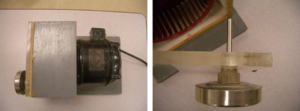Model Description
This is a demonstration of the basic principles energy and energy transfer. It reinforces the concept that internal energy is one of the three forms of energy and that energy can be transferred as work. This demonstration should take 15 minutes.
Engineering Principle
Most students arrive to their basic Thermodynamics course with an understanding of kinetic and potential energy. However, they may not be as familiar with internal energy and how energy is transferred via work. This demonstration reinforces the 1st Law of Thermodynamics for a stationary, closed system.
What You Need
| Item | Quantity | Description/Clarification |
|---|---|---|
| Electric Motor | 1 | Small electric motor with a shaft output. |
| Fan | 1 | A small fan (centrifugal or ‘squirrel cage’) attached to the shaft of the electric motor.
You need to agitate the air inside the fan box in order to increase the Internal Energy, thereby raising the temperature inside the box. |
| Plexiglass box | 1 | Used to encase the fan. |
| Thermometer | 1 | Mounted inside the plexiglass case, near the fan. |
| Cardboard Box | 1 | Used to hide the fan box prior to the demonstration. Cut a hole in the box to allow students to see the thermometer display. |
Total build time is estimated as 2-3 hours.
How It’s Done
Before Class: Obtain the proper materials and build the fan box device. The fan box above uses an electric motor with an output shaft. The motor used was 1/6 hp, but that exact power is not necessary. The motor is mounted to a flat, wooden platform to hold the motor and box in place. The box itself consists of a wooden case approximately 12” high by 12” wide. The exact dimensions are left to the user, but it must be deep enough to house the centrifugal fan inside. The front face of the box is plexiglass and hinged to allow the door to open. A standard thermometer is drilled into the plexiglass to allow the temperature probe to sit near the outer edge of the centrifugal fan. Smaller wooden wedges are placed around the corners of the box to reduce the amount of air in the box around the fan.
In Class:
After a discussion on energy and energy transfer, observe the temperature on the thermometer inside the ‘mystery device’ (figure below, left). Then turn on the fan and observe the temperature rise. Ask questions about what could cause the temperature inside the device to rise. Tie the conversation back to the concept of Internal Energy. At this point, many students will assume there is some type of heating element inside the device, neglecting the fact that work is also a form of energy transfer. Finally, remove the cardboard box revealing the fan inside the plexiglass container (figure below, right), and discuss the differences between heat transfer and work.

Observations: Students should be able to observe how electrical energy is converted to mechanical energy from the wall outlet to the fan shaft. They can then observe how that mechanical energy is transferred to the air inside the fan box in the form of Internal Energy, as evidenced by the rise in temperature inside the box.
Additional Application: After the demonstration have the students draw a schematic of the device with the cardboard box as the boundary. In this case, the electrical energy is the only energy transfer across the boundary (Scenario 1). Then, have the students draw the system again with the plexiglass container as the boundary (Scenario 2). Discuss how the interactions are different, based on how you choose the system boundary.



